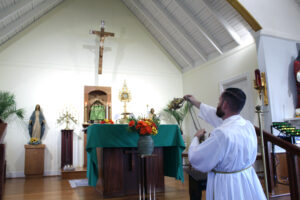With the focus of the three-year National Eucharistic Revival having turned to parishes, Bishop Koenig is asking those in the Diocese of Wilmington to make eucharistic adoration available for a week beginning Nov. 26.

All priests and deacons have been asked to speak about the Eucharist at Mass, and times will be coordinated among parishes for adoration, the bishop said in a recent interview.
The three-year revival began in June 2022, with the first year concentrating on the diocese. In Wilmington, it included a procession through the streets of the city with Bishop Koenig carrying a monstrance at the head of the line. The diocese also had presentations on the Eucharist in schools and parishes, he said.
Eucharistic Adoration Week begins the Sunday after Thanksgiving and runs through the first Sunday of Advent, which is Dec. 3. Bishop Koenig said this is the rare year when Advent does not begin the Sunday after Thanksgiving, so the diocese is taking advantage of the break by concentrating on adoration.

“We thought that this would be an opportune time, the week in November, to focus in on especially the Mass,” he said. “The Eucharist and eucharistic adoration is certainly a great devotion, a great source of prayer and strength.”
The Mass is the greatest gift we have as Catholics, he continued, and the Eucharist is a central part of that experience. The bishop recalled a homily given by the late Pope Benedict XVI at the closing Mass for the Italian National Eucharistic Congress in 2005. Pope Benedict spoke about how the Emperor Diocletian forbade Christians from gathering on Sundays to celebrate the Eucharist, among other activities.
A group of 49 Christians were surprised one Sunday when they were caught celebrating Mass, and they were arrested and taken to Carthage to be interrogated. One of the arrested was asked why the group had defied the emperor’s orders.

“He replied, ‘Sine dominico non possumus’: that is, we cannot live without joining together on Sunday to celebrate the Eucharist. We would lack the strength to face our daily problems and not to succumb,” according to a transcript on the Vatican website. All 49 were killed.
“It really kind of highlights the gift of the Eucharist that sometimes we can take for granted,” Bishop Koenig said.
It can become something ordinary, he added, “which is a blessing, however, it’s also good to deepen our understanding of what takes place during the Mass.”
Bishop Koenig said an episode from Jesus’ life comes to mind when he thinks about adoration.
“I think back to Jesus in Gethsemane, where he says to the apostles, ‘Could you not stay here and pray with me for a while?’ That to me is what eucharistic adoration is about. It’s about being in the presence of the eucharistic Lord,” he said.
God is present everywhere, he continued, but especially in the Eucharist. To be able to sit and have the Eucharist exposed in the monstrance is a way in which Catholics are especially aware, visually aware, of Christ’s presence.

While all parishes are being asked to have adoration at some point, Bishop Koenig does not see that as something that should be forced on them on a more permanent basis. Each parish has different circumstances that could affect whether they could make it possible. It takes planning and preparation and includes safety concerns, scheduling and other factors, he said.
“If we’re going to have exposition, we’re going to need someone there present. It takes a good amount of effort to make sure someone’s present during the exposition. If it can be worked out, that’s great, but I wouldn’t want a parish to feel like they have to bite off more than they can handle,” he said.
One of the hopes for the week of adoration is that those who attend and reflect on the Eucharist and the Mass will have something from that stay with them. It’s a very busy time of year, with Christmas and the new year approaching, but to have a week between Thanksgiving and Advent may offer people time to slow down and reflect, the bishop said.
He said the Thanksgiving season is a natural time to have adoration.
“It’s really appropriate after a national day of thanksgiving that we’re giving thanks to the Lord with the Eucharist and we’re preparing to enter the season of Advent,” he said.
The three-year revival concludes with the National Eucharistic Congress next July at Lucas Oil Stadium in Indianapolis. It will be the first such gathering in the United States in 83 years. One of the aspects of the congress is a pilgrimage with the Eucharist from four different directions that will converge on Indianapolis. The “Seton Route,” which covers the eastern part of the United States, will begin in New Haven, Conn., and stop in Philadelphia and Baltimore along the way.
More information about the congress, including activities and registration, is available at www.eucharisticcongress.org.






